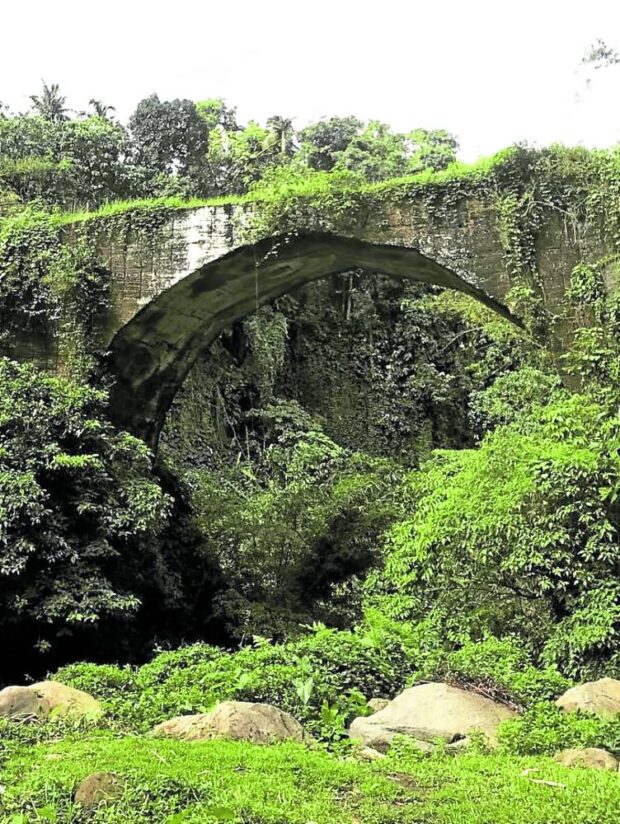
Majayjay, one of Laguna’s upland towns, is largely known for its national cultural treasure church dedicated to San Gregorio Magno, which is located in an area with a commanding view of the lowlands, including Laguna de Bay.
That is if one is perched on top of its pediment or situated inside its five-tiered belfry, a possibility if allowed by church authorities.
Within the area of the church and inside the poblacion are other heritage buildings comprising the town’s built environment, such as the municipio, cemetery, old houses, ruins of the presidencia and a chapel dedicated to the Nuestra Señora de la Porteria.
This town, founded by the Franciscans in the late 16th century in a place called May-it (now a barangay), is perhaps also known for a controversial unfinished bridge allegedly linked to friar abuse.
Called Puente de Capricho, this bridge was built to supposedly cut travel time from Majayjay to neighboring towns of Magdalena, Pagsanjan and Sta. Cruz.
It is also called Tulay Pige as, according to oral tradition, its workers were allegedly whipped on their thighs for committing mistakes while they were building the bridge in the mid-19th century.
Exceedingly bold
Capricho was purportedly built only on a whim, but actually it made sense, since travelers from the town center do not need to go south, cross the Puente de Olla at the upper portion of the Olla River and go down the road to Magdalena, passing by the area where the Puente de Capricho is located.
Although not finished, this bridge was built by Fr. Victorino del Moral in 1851 and was noted to be “exceedingly bold for its execution and intelligence.”
In the turn-of-the-20th century survey by Dominican priest Valentin Marin of works done by religious orders in the country, he noted that Del Moral “used nothing but reeds, bamboo, palms, and bongas” in the construction of the bridge.
He also noted that “in spite of the damage caused throughout the land by the terrific earthquakes of September 16, 1852, June 3, and that of 1880, the bridge still exists in the same state in which it was left by Father Victorino.”
Del Moral was Majayjay’s parish priest from 1850 to 1854.
Most number of bridges
Puente de Capricho is one of the seven Spanish-era bridges built in Majayjay that were mentioned by Marin in his book, “Ensayo de una sintesis de los trabajos realizados por las Corporaciones eligiosas Españolas,” first published by the University of Santo Tomas in 1901.
However, a recent survey conducted by this writer and John Valdeavilla of the Tuklas Tayabas Historical Society revealed there are at least 10 bridges built by the religious during the Spanish period, perhaps the most in Spanish-era Laguna.
Aside from the Puente de Capricho, it also had the aforementioned Puente de Olla, which was inaugurated in 1874.
This single-arched stone bridge was, however, destroyed during the onslaught of Typhoon “Santi” (international name Mirinae) in 2009, the same storm that also destroyed Puente de Atilo downstream.
Not far from this bridge in Barangay San Miguel is another single-arched stone bridge most likely built also in the 19th century. This bridge is located below an American-era concrete bridge and thus hidden from view.
This bridge is one of seven extant bridges in Majayjay that were built using either silleria (cut stone) or mamposteria (rubblework).
In varying states of conservation, these include two at the Oobi River, with one located near the church and one on Arellano Street, all in the Poblacion.
to Majayjay” book
Three others are located at the river that runs along the left side of the church. One is located on F. Balagtas Street near the town market, one upstream on Calles Street, and one further upstream on Arellano Street.
All of these bridges were built by the Franciscan Order, the same religious congregation that built more than 20 bridges and small bridges called puentecitos in the neighboring town of Lucban and the city of Tayabas in Quezon Province. —CONTRIBUTED
Author’s note: More of Laguna’s built heritage is covered in the recently published book “Scenes, Sense, Sites: Reasons to Love Laguna.” This book, published by the provincial government and Big Idea Productions, features Laguna’s natural and cultural heritage as well as sites being promoted for tourism.

